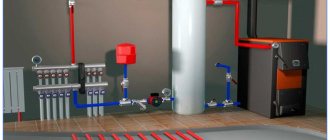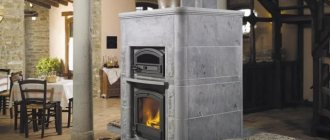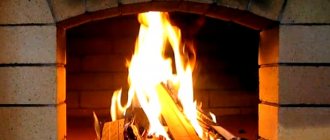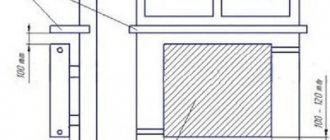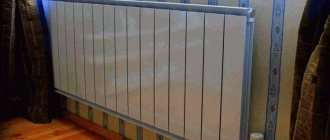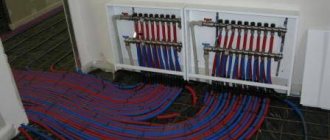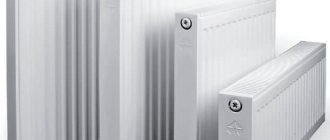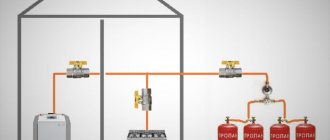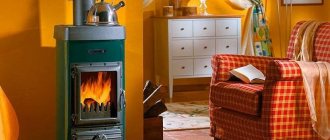Advantages of metal stoves
Metal household heating stoves have an extensive list of advantages:
- Metal differs from ceramics in being much more flexible and soft, but the strength of these materials is quite comparable. The material in question is easy to melt, cut and bend, it can be drilled and forged, and the finished products do not require firing. In general, metal can be processed in a large number of ways, and this quality is clearly an advantage.
- The versatility of processing allows the creation of metal furnaces to use a lot of innovations aimed at improving the technical characteristics of the furnace. Thanks to structural changes, the efficiency of metal stoves can reach 90%, while conventional brick stoves produce about 70%.
- In the case of brick kilns, reducing the wall thickness reduces the strength of the entire structure. With metal, everything is exactly the opposite - even a very thin sheet is distinguished by its solid strength. This makes it possible to reduce the weight and cost of metal stoves several times compared to brick ones.
- Light weight and solid construction, in turn, greatly simplify the transportation of metal structures. Here it is also worth considering the strength, which gives the product excellent resistance to mechanical damage. One cannot fail to note the ease of installation - firstly, a lightweight metal stove for a home does not require a separate foundation, and secondly, its low weight allows the structure to be installed with relatively little effort.
- Another important advantage that deserves attention is the good thermal conductivity of the metal. This factor suggests that the stove’s own heat capacity is small, so the heat it generates is used only to warm up the house, which ensures high efficiency. For comparison: in brick kilns, about 20% of thermal energy is spent on heating the structure itself.
- The composition of the metal is quite homogeneous and, unlike brick, does not have a porous structure. It is also worth noting the high resistance to dampness and interruptions in heating operation. Metal wood-burning stoves do not require regular or boost kindling at all. Another advantage is the ease of installation of the hob and water heating circuit, which is facilitated by the high thermal conductivity of the material and the high rate of afterburning of gases.
- Industrially produced stoves are certified as fireproof devices, so after purchasing, all that remains is to install them. True, there are some models that require special permits for operation, but this factor does not always manifest itself.
Furnace materials
An iron stove for a home should be selected taking into account a number of factors and parameters of the design itself. The technical characteristics and design features of the stove directly affect its efficiency and reliability. One of the most important parameters is the material used to make the stove.
Different materials can be used for the production of metal furnaces:
- Steel;
- Heat-resistant steel;
- Cast iron.
As a result, structures assembled from these materials have a number of differences, so it is worth considering each type in more detail.
Frequently asked questions
Selecting and operating metal furnaces is a complex undertaking. Inexperienced people have a lot of similar questions. Let's answer the most common ones:
Which type of fuel is more economical?
It is generally accepted that maximum savings can be achieved with gas furnaces. Other designs are more consumable, especially electric ovens.
How to avoid burns from the stove body in a small room?
There are different types of fencing. Some owners line the stove with bricks, increasing the uniformity of heating and the cooling time. The choice of the appropriate option depends on the personal preferences of the owner.
What size heater is needed so that you can safely provide steam in a Russian bath?
The larger the heater, the better. It is believed that in a Russian bath you can use stoves with a heater of 100 kg or more. However, here it is necessary to take into account the design features and shape of the stove itself.
Which stoves are more convenient, with a long or short fuel tunnel?
It is generally accepted that furnaces with a long tunnel are most convenient. However, in practice, everything depends on the type of fuel and the specifics of its use.
Is it necessary to install protective fire barriers for a metal stove?
It all depends on the design features. Some models can be installed without fire protection elements. However, in this matter you should consult with a software inspector, who will inspect the stove and give a competent recommendation.
It all depends on the design features. Some models can be installed without fire protection elements. However, in this matter you should consult with a software inspector, who will inspect the stove and give a competent recommendation.
Steel furnaces
The most popular material for the manufacture of metal furnaces is ordinary steel. This material can easily withstand stable temperatures of up to 400 degrees, and during short-term kindling this value can reach 600 degrees. The thickness of steel usually starts from 4 mm, but one must take into account the high rate of metal burning at high temperatures - i.e. For cold regions this option is not practical.
However, there are long-burning stoves, the body of which is simply not subjected to prolonged high-temperature heating. At the same time, heat transfer is maintained at the proper level due to heat accumulators made of more durable materials. Such an iron wood-burning stove is quite suitable for heating large houses located in regions with a harsh climate.
Heat-resistant steel stoves for home
The next material from which metal furnaces can be made is heat-resistant steel. The minimum metal thickness in this case is 3 mm, which makes it possible to further reduce the weight of the structure. The efficiency of such devices often exceeds 80%, and the service life is 20 years. Metal stoves made of heat-resistant steel are safe, efficient and very easy to install - just install such a structure on the floor and connect it to the chimney.
Optionally, heat-resistant stoves are equipped with a hob and a water heater, which allows them to be used both in the country and in houses with year-round use. Unlike steel stoves, devices made of heat-resistant steel have a complex design, so such an iron stove for a summer house cannot be created with your own hands - it will be much easier to purchase and install a ready-made device.
Simple heater for a summer house
Such a heating metal stove is well suited for quickly providing heat to a small bathhouse or even a sauna.
The main advantages are that it is mobile and easy to manufacture.
Preparing for vaping takes 1.5 hours, the walls heat up quickly. One caveat - you need to attach 2 chimneys to the stove. The first will participate in heating the room itself, the second will remove carbon monoxide.
What does the oven consist of:
- Steel - iron sheets of at least 3 mm.
- It is better to make the firebox from thicker steel -6 mm.
- The kit also includes latches and a metal grill.
This structure can be assembled using a welding machine. Such sets are purchased in a disassembled state, the instructions are already included. Designing a metal stove will not be difficult, as it will fully comply with fire safety rules.
Cast iron stoves
Another material that is suitable for creating metal stoves is cast iron. In terms of strength characteristics, cast iron is not inferior to steel, but at the same time its heat capacity and fragility are comparable to ceramics. An iron stove for a home takes longer than half an hour to warm up, but after one kindling it provides heating for the house for three hours.
The width of cast iron used for the production of stoves varies from 6 to 25 mm. If the layer of material is thicker, but the thermal expansion is too great, the oven may be damaged. Cast iron that is too thin is also not suitable - the stove will be too fragile.
The efficiency of cast iron stoves is quite high, but it can only be realized if the area of the heated house does not exceed 60 m2. In houses with a larger area, a cast iron stove simply will not be able to operate, and the temperature in the rooms will not be comfortable enough.
However, cast iron itself can easily withstand fire breaks and dampness, so such structures can be successfully used in various outbuildings that require periodic heating. Self-assembly of a cast iron stove is not possible - cast iron is very difficult to process, and such work cannot be done at home.
Preparing for installation
Equipping a dacha with stove heating with your own hands begins with preparation:
- The walls and floor closest to the device are covered with ceramic tiles.
- If the floor is wooden, then at the first stage drywall is placed on it. Then the ceramic tiles are attached with self-tapping screws. A layer of primer is applied on top, and it dries within 24 hours.
- If the base is concrete, then the tiles are laid directly on the glue.
- When using tile adhesive, use a notched trowel. The ceramic layer is laid out using a level.
- The tiles are laid end-to-end or with a gap using construction crosses.
- After the solution has hardened, the crosses are removed and the joints are rubbed.
- Wall tiles are laid using the same technology.
Diagram of an example of installing a stove in a bathhouse
Chamber furnaces
A metal chamber stove is a “potbelly stove” familiar to many people, only modified to meet modern requirements for heating equipment.
The technical characteristics of such devices are as follows:
- Heat transfer is carried out mostly due to convection, and only a quarter of the generated heat comes from the body itself;
- There is no likelihood of condensation occurring, and the outlet gas temperature exceeds 100 degrees;
- The chimney must be cleaned no more than once a year;
- Efficiency reaches 60% when using coal and firewood.
You can create a metal heating stove with your own hands without much difficulty, but the process of its construction should be given a separate article.
Fire safety
In addition to the correct installation of the stove, it is necessary to carry out the installation in accordance with fire safety standards. Especially if the cottage is built of wood.
When installing a stove with your own hands, you must adhere to the following rules:
- The floor is lined with non-combustible materials. The place is covered with concrete, ceramic tiles or iron sheet. The parameters of this place must exceed the dimensions of the oven by
- Nearby walls or furniture are also separated with non-flammable material. For example, a sheet of asbestos. Then the minimum distance from the hot stove to the wall can be 20 cm.
- If there is no insulating material, the distance increases to 1 meter.
- The chimney system is equipped with protective elements. They protect the passage from clogging and nesting birds.
- The distance from the ceiling to the top surface of the equipment body is 1.2 meters.
- It is advisable to enclose the device with a decorative fence.
- If passages are made in the walls to heat adjacent rooms, then heat-resistant materials must be used during the work.
Channel furnaces
In channel-type furnaces, the following principle works: gases burn, cool and pass through channels between the partitions, where the process of heat transfer to the body of the device occurs. To operate such a furnace, it requires heating to 400 degrees so that the afterburning process can be activated. You can create such a metal stove for a summer residence with your own hands without any problems on the basis of a regular potbelly stove - for modification you need to leave only a horizontal section of the gas pipeline so that it separates the firebox and combustion chamber.
The oxygen necessary for combustion enters the oven through cracks in the hob or an air choke. The efficiency of channel devices can reach 80%, and their thermal power is several times higher than that of chamber devices. Channel-type stoves can operate both in normal mode and in long-burning mode, regardless of the fuel used.
The heating power varies due to the air supply, and the possibility of adjustment is an order of magnitude higher than with chamber devices. The temperature in the afterburning chamber reaches 250-300 degrees, which is quite enough for comfortable use of the hob.
Most household stoves with a power of no more than 15 kW are created using a channel design. For the manufacture of the body, 4 mm steel is most often used, and the hob is made of cast iron or steel with a thickness of 8 mm.
Main manufacturers
Let's look at the most popular manufacturers on the modern metal furnace market.
Teplodar
Teplodar - model “Vertical” (increased long-burning mode gives 8 hours of heating without adding fuel), “Stove” is equipped with a hob with removable rings, “Top Model” and “Matrix” can act as a fireplace due to fireproof glass in the doors , from where the flame is visible. The T-80 model can be equipped with a smoke exhaust.
The stoves of this manufacturer are designed to heat houses with an area of 80-300 m3, and the cost is scattered within 10-25 thousand rubles.
Ephel and Bayard
Efel is a Belgian manufacturer that leads the European home heating technology market. Thus, the “Harmony” model has a power of 12.5 kW and runs on wood and coal with a burning duration of 10 hours. That is, the oven can work all night.
The cost of such a stove is high - from 130 thousand rubles. Bayard 12 is a classic model with a hob and minimal gas emissions (0.28%). Its price is approximately 110 thousand rubles.
Eco fireplace
Another reliable company is Ecofireplace. It produces stoves that combine quality, safety and beauty. High-quality steel is used, and the facade is finished with tiles - this is aesthetically pleasing.
Thus, the Bavaria Arch model with a cast iron grate and heat-resistant glass on the doors opens up a view of the flame. This wall-mounted stove has economical fuel consumption (usually wood) and a glass self-cleaning mechanism. Such models cost about 40 thousand rubles.
The Bavaria Baroque model with a cast iron hob and a 6 mm thick fireproof steel body provides an efficiency of 78%.
Meta
produces wood-burning stoves that are maximally adapted to the Russian climate. All models have a hob with durable cast iron burners, are compact and safe.
Thus, the “Narva” series with ceramic lining and fire-resistant paint on top of a metal body is equipped with ash pans, firewood, and a glass combustion door. Its power is 6 kW and is capable of heating a house or cottage of 60 m2. Its price in the budget segment is 20 thousand rubles. "Meta Gnome-2" is the most compact model from the Meta manufacturer. Its dimensions are 363*502*640 mm and weighs 38 kg, and its power is 5 kW, which is suitable for heating a room of 50 m2.
Termofor
Finally, the Termofor company. Small-sized models for dachas and outbuildings “Selenga”, “Pichuga”, “Student”, “Avoska”, “Cinderella” are known here, which are easily portable, as well as models for heating the house - “Turbo”, “Normal”, air-heating models – “Associate Professor”, “Professor”, “Butakov”.
The latest options are very large and are permanently mounted. Prices range from 10-50 thousand rubles. Reviews about Selenga are very good: it is a beautiful oriental-style model that saves fuel well and can heat a house of 85 m2.
Bell furnaces
The last type of metal furnaces is bell furnaces. With this scheme, the gases remain under the roof of the bell until they completely burn out. Then the temperature of the burnt gas decreases, it goes down and transfers the remaining heat to the stove. This design allows you to achieve an efficiency of 70%.
This operating scheme also works well in metal heating boilers - only in this case there is no open flame, since the cap is not designed to absorb excessive amounts of heat. That is why bell furnaces operate in smoldering mode. When using firewood, the burning time reaches 60 hours, and when using coal, such structures can work for almost a month.
You can create such a metal stove for your dacha with your own hands without much effort, and the assembled structure can easily operate on both wood and coal. The only limitation is the moisture content of the fuel - it must be minimal, since it is impossible to ensure smoldering of wet fuel. Stoves originally designed only for the use of coal cannot burn wood - this point needs to be thought out in advance.
Furnaces of this type are often connected to water heating circuits, which not only provide hot water, but also enhance convection. Such stoves are actively used for heating large houses, regardless of their geographical location.
Where is the best place to install?
The choice of location for installing the furnace device must be approached thoroughly:
- It is better to place it away from external walls. This way you will retain a large amount of heat and the most optimal efficiency indicators.
- If your product is small in size and therefore weighty, it can be installed directly on the floor. If you have a rather heavy option, then it is better to make a foundation. It is not necessary to fill the perimeter with concrete; even a reinforced concrete slab can serve as the basis.
- When installing, you need to maintain a distance to the walls, which should not be less than 1 meter. This is especially true for flammable coatings.
- Next, you should take care of fire safety and call an inspector. He must approve the installation and issue the appropriate permit.
